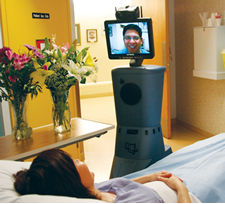
A robotic Dr Mendez checks
in on a patient remotely
Photo: Roy Dempsey |
Like most busy physicians, Dr Ivar
Mendez always wished he could be in two places at once.
Thanks to his new remote-presence robot, now he can.
The robot — which looks like
R2D2 meets Max Headroom — allows the head of the
Department of Neurosurgery at the QEII in Halifax and
founder of the Brain Repair Centre to check in on his
patients no matter where he is — and help bring
medical attention to parts of the world with a shortage
of specialists.
The technology is not new, but
it's the first time it's been used in Canada. The robot
was designed by California-based In Touch Technologies
and is slightly shorter than the average man. Its dark
grey body is topped with a flat-screen computer monitor
that can rotate 360 degrees and tilt up and down, acting
as the doctor's face — and eyes. The camera inside
the robot has a 180-degree view — just like human
eyes, notes Dr Mendez — that can zoom in on objects
in great detail. The doctor operates the robot through
a computer that has special software, which is connected
to the internet. And much like a video game, a joystick
allows the physician to control the movements of the
robot. It may look ungainly, but Dr Mendez says the
machine, which moves around on wheels, is surprisingly
agile. "It's so precise you can navigate all the obstacles
in a room."
DR
ROBOTO
Dr Mendez is no stranger to the world of robots. In
2002, he and his team did the world's first remote robotic
tele-mentoring neurosurgery on a patient in Saint John,
NB, from Halifax, 400 km away. The QEII acquired the
new robot only about a month ago, but Dr Mendez says
it's already become an integral part of his team. The
jetsetting brain surgeon has wasted no time trying it
out. At the end of May he was attending conferences
in Geneva and London and used the robot to keep in touch
with patients in Halifax.
"It was just like regular rounds,"
he beams. "I was on the other side of the Atlantic and
controlling the robot in real time. It was wonderful
to be able to see my patients while I was away, and
my patients were happy to see me."
Dr Mendez says the fact that the
doctor and patient are essentially face to face means
bedside manner doesn't suffer.
"Whatever the doctor is doing perfectly
transfers to the patient. They can see your face, they
can see your expressions. And after about five to 10
minutes of talking with somebody, the individual forgets
it's an interface and you start truly communicating
to the person on the other side. They don't feel it's
weird or fake. They actually welcome the ability to
have a doctor interact with them in real time."
The robot makes friends wherever
it goes, it seems. "There is a total acceptance of the
robot by the nurses, for example," says Dr Mendez. "The
robot doesn't get any special attention. It walks through
the wards and people have gotten completely used to
it."
BOT
ON THE MOVE
The robot will soon be headed to a hospital in Cape
Breton, so specialists in Halifax can monitor their
patients there remotely. Dr Mendez predicts eventually
nurses and doctors throughout the province will be using
robots as part of their practice.
"I think it will probably be used,
initially, in emergency rooms and intensive care units
and peripheral hospitals," he say.
This real-time technology promises
to be a boon for rural medicine in particular, which
is especially useful in a vast country like Canada.
"If you go to the emergency room and you are thousands
of miles away from a big centre where the specialist
is, that specialist will be able to look at you and
help with your care," says Dr Mendez.
He'd also like to see the robot
do a little jetsetting itself. Dr Mendez, who does a
lot of volunteer medical work in his native Bolivia,
says the robot could be used anywhere there's a dearth
of specialists. That includes remote areas of Afghanistan
where doctors tending to a soldier needing surgery can
consult with specialists located elsewhere.
|